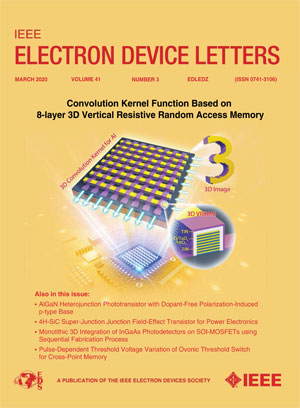A Snapback-Free and Fast-Switching SOI LIGBT With Integrated Double Self-Biased MOSFET
IF 4.1
2区 工程技术
Q2 ENGINEERING, ELECTRICAL & ELECTRONIC
引用次数: 0
Abstract
A novel SOI-LIGBT integrating a Double Self-driving MOSFET (DSM) is proposed. The DSM consists of a Self-Biased P-MOS (SBP) with a shorted main gate and a Self-Biased N-MOS (SBN) with a shorted auxiliary gate. These components are designed to function without additional gate signals, and they are driven automatically by the operating state of the LIGBT. During forward conduction, the SBP (集成双自偏置MOSFET的无闪回快速开关SOI灯
提出了一种集成双自驾车MOSFET (DSM)的新型soi - light。DSM由带短路主栅极的自偏置P-MOS (SBP)和带短路辅助栅极的自偏置N-MOS (SBN)组成。这些组件被设计成在没有额外门信号的情况下工作,并且它们由light的工作状态自动驱动。在正向传导过程中,SBP (${V}_{\text {GS,{P}}} \gt {V}_{\text {thp}}$)关闭,而SBN随着${V}_{\text {CE}}$的增加逐渐开启。SBN的p埋底物为电子载流子创造了一个潜在的屏障,有效地消除了snapback效应。在反导过程中,SBP (${V}_{\text {GS,{P}}}} \lt {V}_{\text {thp}}$)导通,SBN关断,与pn结二极管串联起P- mos作用。在关闭期间,SBP (${V}_{\text {GS,{P}}} \lt {V}_{\text {thp}}$)和SBN (${V}_{\text {GS,{N}}} \gt {V}_{\text {thn}}$)被重新激活以提取多余的载波。因此,dsm - light在${V}_{\text {ON}}$和${E}_{\text {OFF}}$之间实现了优越的权衡。在${V}_{\text {ON}} =1.22$ V时,${E}_{\text {OFF}}$比sbm - light、tbsa - light和ssa - light分别减少30%、30.32%和68.23%。
本文章由计算机程序翻译,如有差异,请以英文原文为准。
求助全文
约1分钟内获得全文
求助全文
来源期刊

IEEE Electron Device Letters
工程技术-工程:电子与电气
CiteScore
8.20
自引率
10.20%
发文量
551
审稿时长
1.4 months
期刊介绍:
IEEE Electron Device Letters publishes original and significant contributions relating to the theory, modeling, design, performance and reliability of electron and ion integrated circuit devices and interconnects, involving insulators, metals, organic materials, micro-plasmas, semiconductors, quantum-effect structures, vacuum devices, and emerging materials with applications in bioelectronics, biomedical electronics, computation, communications, displays, microelectromechanics, imaging, micro-actuators, nanoelectronics, optoelectronics, photovoltaics, power ICs and micro-sensors.
 求助内容:
求助内容: 应助结果提醒方式:
应助结果提醒方式:


